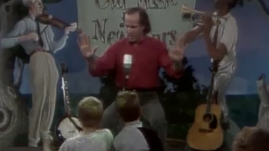Teachers' Domain - Digital Media for the Classroom and Professional Development
User: Preview



Folk singer John McCutcheon demonstrates the hambone, an African-American rhythm technique that uses the whole body as a “drum set” to produce different sounds.
Find additional arts resources for your classroom at the KET Arts Toolkit website.
Hambone was created by enslaved Africans in North America. Forbidden to use their drums, slaves found ways to make rhythms with tambourines, bones, and body music such as hand clapping and body and thigh slapping, also called “Pattin’ Juba.”
The term “hambone” refers to the daily activities of the early African-American slave communities. In the days of slavery, families had to stretch the little food they were given, relying on their resourcefulness and creativity to survive under adverse conditions.
The hambone (the bone of a ham) was used to make a big pot of soup, which, with lots of water, and little scraps of vegetables and spices, was stretched to feed many families. That same hambone would be passed around and used repeatedly in different pots of soups, making something from nothing as a way of survival. The word “hambone” was then adopted as the name of the system of improvised rhythmic body music that enabled slaves to make music without their drums.
Using the same resourcefulness to perpetuate their traditions, the dance and music style of “hambone” was created, allowing cultural, sacred, and historic rhythms to survive and evolve. The use of the word hambone, and the practice itself, could be thought of as symbolic, a way to honor the cultural memory of the determination and creativity of African Americans in the United States throughout their history.
John McCutcheon demonstrates the “hambone,” which he learned from an African-American carnival performer when he was a child. He says, “It uses the whole body as a ‘drum set’—feet, arms, chest, face, and legs—to produce different sounds and combine these sounds for both accompaniment and solo work. My first exposure to hambone included a sing-song based on ‘The Mockingbird.’”
Hambone, Hambone, where you been?
‘Round the world and back again.
Hambone, Hambone, have you heard?
Papa’s gonna buy you a mockingbird.
If that mockingbird won’t sing...
 Loading Standards
Loading Standards